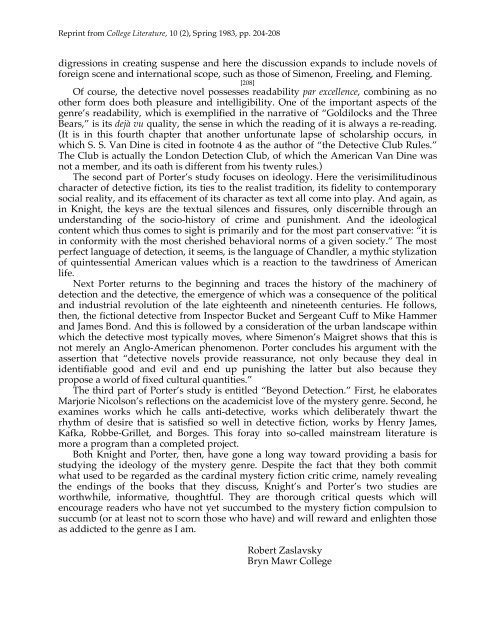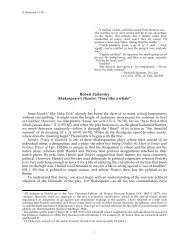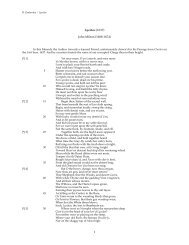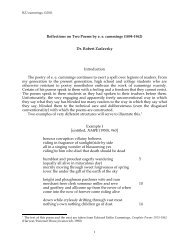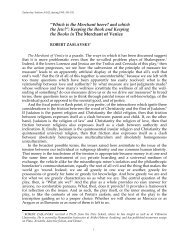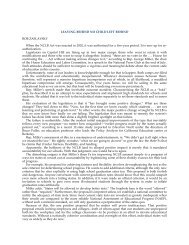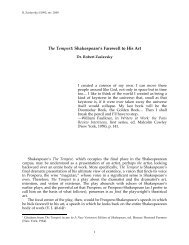Stephen Knight. Form and Ideology in Crime Fiction. Bloomington ...
Stephen Knight. Form and Ideology in Crime Fiction. Bloomington ...
Stephen Knight. Form and Ideology in Crime Fiction. Bloomington ...
Create successful ePaper yourself
Turn your PDF publications into a flip-book with our unique Google optimized e-Paper software.
Repr<strong>in</strong>t from College Literature, 10 (2), Spr<strong>in</strong>g 1983, pp. 204-208digressions <strong>in</strong> creat<strong>in</strong>g suspense <strong>and</strong> here the discussion exp<strong>and</strong>s to <strong>in</strong>clude novels offoreign scene <strong>and</strong> <strong>in</strong>ternational scope, such as those of Simenon, Freel<strong>in</strong>g, <strong>and</strong> Flem<strong>in</strong>g.[208]Of course, the detective novel possesses readability par excellence, comb<strong>in</strong><strong>in</strong>g as noother form does both pleasure <strong>and</strong> <strong>in</strong>telligibility. One of the important aspects of thegenre’s readability, which is exemplified <strong>in</strong> the narrative of “Goldilocks <strong>and</strong> the ThreeBears,” is its dejà vu quality, the sense <strong>in</strong> which the read<strong>in</strong>g of it is always a re-read<strong>in</strong>g.(It is <strong>in</strong> this fourth chapter that another unfortunate lapse of scholarship occurs, <strong>in</strong>which S. S. Van D<strong>in</strong>e is cited <strong>in</strong> footnote 4 as the author of “the Detective Club Rules.”The Club is actually the London Detection Club, of which the American Van D<strong>in</strong>e wasnot a member, <strong>and</strong> its oath is different from his twenty rules.)The second part of Porter’s study focuses on ideology. Here the verisimilitud<strong>in</strong>ouscharacter of detective fiction, its ties to the realist tradition, its fidelity to contemporarysocial reality, <strong>and</strong> its effacement of its character as text all come <strong>in</strong>to play. And aga<strong>in</strong>, as<strong>in</strong> <strong>Knight</strong>, the keys are the textual silences <strong>and</strong> fissures, only discernible through anunderst<strong>and</strong><strong>in</strong>g of the socio-history of crime <strong>and</strong> punishment. And the ideologicalcontent which thus comes to sight is primarily <strong>and</strong> for the most part conservative: “it is<strong>in</strong> conformity with the most cherished behavioral norms of a given society.” The mostperfect language of detection, it seems, is the language of Ch<strong>and</strong>ler, a mythic stylizationof qu<strong>in</strong>tessential American values which is a reaction to the tawdr<strong>in</strong>ess of Americanlife.Next Porter returns to the beg<strong>in</strong>n<strong>in</strong>g <strong>and</strong> traces the history of the mach<strong>in</strong>ery ofdetection <strong>and</strong> the detective, the emergence of which was a consequence of the political<strong>and</strong> <strong>in</strong>dustrial revolution of the late eighteenth <strong>and</strong> n<strong>in</strong>eteenth centuries. He follows,then, the fictional detective from Inspector Bucket <strong>and</strong> Sergeant Cuff to Mike Hammer<strong>and</strong> James Bond. And this is followed by a consideration of the urban l<strong>and</strong>scape with<strong>in</strong>which the detective most typically moves, where Simenon’s Maigret shows that this isnot merely an Anglo-American phenomenon. Porter concludes his argument with theassertion that “detective novels provide reassurance, not only because they deal <strong>in</strong>identifiable good <strong>and</strong> evil <strong>and</strong> end up punish<strong>in</strong>g the latter but also because theypropose a world of fixed cultural quantities.”The third part of Porter’s study is entitled “Beyond Detection.” First, he elaboratesMarjorie Nicolson’s reflections on the academicist love of the mystery genre. Second, heexam<strong>in</strong>es works which he calls anti-detective, works which deliberately thwart therhythm of desire that is satisfied so well <strong>in</strong> detective fiction, works by Henry James,Kafka, Robbe-Grillet, <strong>and</strong> Borges. This foray <strong>in</strong>to so-called ma<strong>in</strong>stream literature ismore a program than a completed project.Both <strong>Knight</strong> <strong>and</strong> Porter, then, have gone a long way toward provid<strong>in</strong>g a basis forstudy<strong>in</strong>g the ideology of the mystery genre. Despite the fact that they both commitwhat used to be regarded as the card<strong>in</strong>al mystery fiction critic crime, namely reveal<strong>in</strong>gthe end<strong>in</strong>gs of the books that they discuss, <strong>Knight</strong>’s <strong>and</strong> Porter’s two studies areworthwhile, <strong>in</strong>formative, thoughtful. They are thorough critical quests which willencourage readers who have not yet succumbed to the mystery fiction compulsion tosuccumb (or at least not to scorn those who have) <strong>and</strong> will reward <strong>and</strong> enlighten thoseas addicted to the genre as I am.Robert ZaslavskyBryn Mawr College


